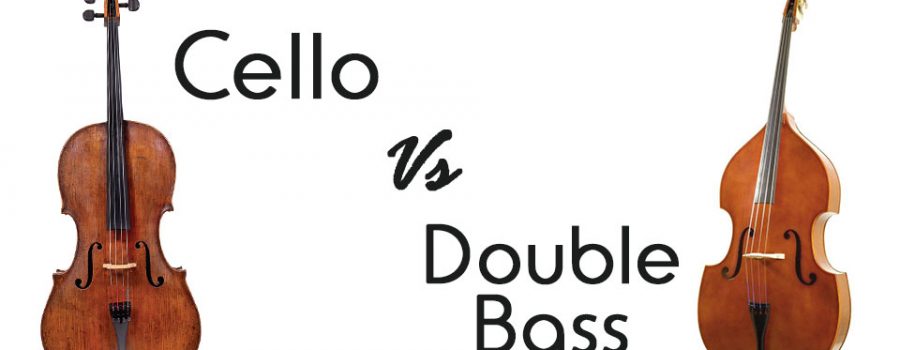The two largest instruments of the string orchestra – the cello and the double bass – are too large and too heavy to be carried on a musician’s shoulder. They rest on the floor, instead, and produce much lower pitches.
The cello and the double bass may look similar from a distance, but they are actually very different.
A cello is played while seated on a standard chair. A double bass is played either standing up, or seated on a high stool. Bass bows come in two different varieties and are held with two different grip styles: French and German. Cello bows are typically a smaller version of the French bass bow.
The Cello

Cello in a concert
The name cello is short for violoncello, which is Italian for “small double bass.”
While the cello is too big to be placed under the player’s jaw like a violin or viola, it is also too small to play while standing up. It is the only instrument that absolutely must be played sitting down.
This instrument is the tenor voice in the orchestra. Its four strings are tuned to the pitches C, G, D, A – exactly one octave below each of the four open strings on the viola. Most cello music will be written in the bass clef, but occasionally moves into tenor clef as the music gets higher. When the music gets very high, the treble clef is used.
The cello has a much deeper and richer tone than both the violin and the viola, due to its larger size and thicker strings. The cello is the second-largest instrument in the string orchestra. It is also the one that sounds the most like a tenor voice.
The cello’s lower strings have a rich, dark sound. It is quite common for composers often write a particular phrase to be played on a certain string, in order to take advantage of this sound.
A large symphony orchestra can have between eight and twelve cellos in a section. Smaller ensembles, of course, have fewer and it’s entirely possible for a small chamber orchestra to get by with just one or two cellists.
How to Hold the Cello
- Sit in a chair with a firm base.
- The neck and scroll of the cello should be to the left of the head, with the C-string tuning peg approximately the same height as the ear. (This may vary, according on the particular instrument and cellist.)
- The cellist should sit straight up and avoid slouching. Some prefer to sit on the edge of the chair, and others like sitting well back on the seat for more back support.
- Adjust the endpin so that the body of the cello gently rests against the chest, its lower half balanced between the knees. Be sure the endpin is rooted securely onto the floor. An endpin holder can keep the cello from slipping.
- Use the knees to firmly keep the cello steady. Do not grip the instrument between the legs.
- Slightly angle the base of the cello to the right, so that the bow can easily reach all of the strings.
The Double Bass

The Double Bass
At over 6 feet long, the double bass is the biggest member of the string family. This instrument is so big that one has to stand up or sit on a very tall stool to play it – having long arms and big hands comes in handy, too!
Like the cello, the body of the double bass rests on the floor, supported by a metal endpin, and the neck of the instrument is aligned with the player’s left shoulder. Its sound is produced the same way as the sound on a cello, using the left hand to change pitches and the right hand to move the bow or pluck the string.
The strings on the double bass, however, are much longer than those on a cello. This extra length allows this instrument to play very low notes. Unlike the other three instruments of the string family, the strings on a double bass are only the interval of a perfect 4th apart from one another: E, A, D, and G (the low E is lower than the cello’s C). In comparison, the cello has a much wider range. The cello can play notes spanning about five octaves, while the bass can play only around four.
The size (and shape) of double bass bodies is not as standardized as that of the cello – so string length can vary between individual instruments. Double basses typically have a lot more variation in their body shape and proportions than cellos. The volume of the cello body is well suited for its tonal range. As a result its shape could be perfected over centuries of time. In contrast, the body of the double bass is actually too small for its range. Making it large enough to suit its very low range would make it too large for any person to play. As a result, bass makers have adjusted the sizes of these instruments to balance tone with practicality.
How to Hold the Double Bass
Standing Position:
- Stand with your feet shoulder-width apart.
- Adjust the length of endpin so the nut of the fingerboard is at the level of your eyebrows. Bass players have differing preferences regarding the proper height of the bass and how to adjust the endpin, so consult your bass teacher for his or her advice. Some recommend that the nut of the fingerboard should be at eye level, while others say the nut should be as high as the top of the head or forehead. Still others adjust the height of the bass using their knuckles: to do so, stand facing the bass (holding the neck of the instrument with your left hand and dropping your right arm straight down against your body) and adjust the endpin so the bridge touches the knuckles or fingernails of your right hand.
- Turn the bass slightly to the right and tilt it back so that it rests against the left side of your hip (some like to rest the bass against the stomach).
- Many bass players use endpin rests to help keep their endpin from sliding.
Sitting Position (using a stool):
- Adjust the length of the bass endpin so the nut of the fingerboard is at the level of your eyebrows when standing.
- Sit on the front half of the stool. Some bass players keep both feet on the floor while playing, while others keep their right foot on the floor, lifting and placing their left foot on a rung of the stool. Select a position that is comfortable for you.
- Turn the bass slightly to the right and lean the back of the instrument on the left side of your stomach.
Bows
Bass players use two different types of bows: the French bow and the German bow.
- The French bow is shorter and heavier than the cello bow, and utilizes an overhand bow hold similar to what cello players use.
- The German bow has a taller frog that requires the bass player to use an underhand bow grip.
Both bows have their advantages. Consult your bass teacher or a fellow bass player for assistance if you’re unsure which bow to use.



